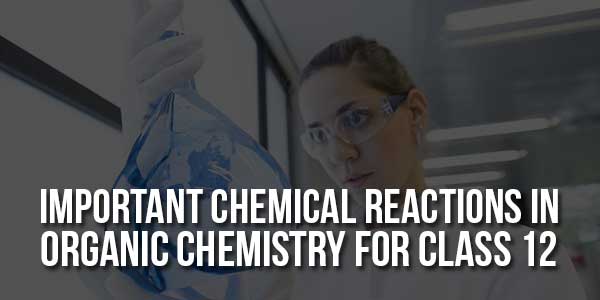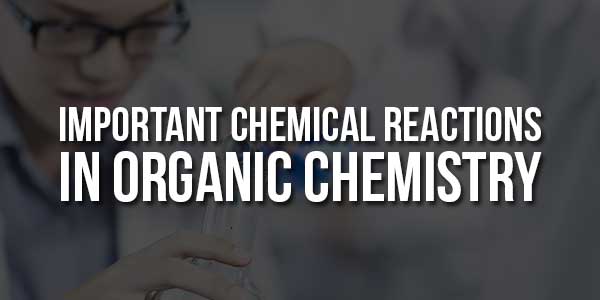
Like any other subject, Chemistry includes several divisions. One of these divisions is organic chemistry. Organic chemistry is the category of chemistry in which we study reactions, structures, compositions, properties, and preparation of carbon-containing compounds
Table of Contents
What is Organic Chemistry?
These include hydrocarbons, buts compounds with different elements like nitrogen, oxygen, halogens, phosphorous, silicon, and stuff.
As time passed, Organic Chemistry branched out, and now it includes the study of manmade products like plastics. Several human-made products like food, pharmaceuticals, explosives, and petrochemicals from cosmetics and paints.
Let’s know about the Class 12 Reactions in Organic Chemistry in this article.
Understanding Organic Chemistry:
The development in organic chemistry has helped society a lot; it has helped in the synthesis of polymers, drugs, and other natural products. An essential part of organic chemistry is synthetic organic chemistry; it involves constructing and designing organic compounds for practical purposes.
The word organic is used because, initially, organic chemistry was limited to compounds produced by biotic creatures only. It was credited to too few of the vital forces found in organic materials because they consist of substances the other present inanimate substances lack.
This theory was found by Urey Miller. He debunked it when he synthesised urea from inorganic substances, but the classification is still in use.
Organic chemistry is massive in overall science because the major key property is shown cased by the element carbon, which is termed as carbon catenation. Carbon has the brilliant ability to create a very stable bond with other carbon atoms while giving it the ability to form stable molecules which have a relatively complex structure.
Cleavage Of Bonds:
Inorganic chemistry, the reactions occur due to the making of bonds and breaking of bonds. In chemistry, a bond holds all the atoms together. A bond can cleave (split) in two ways. They are Homolytic Cleavage and Heterolytic cleavage.
What Is Homolytic Cleavage?
When covalent bonds between any two elements break so that each of the elements gets its electrons, it is called homolytic cleavage. Which means each electron gets its element. This process results in the formation of free radicals.
What Is Heterolytic Cleavage?
When the covalent bonds between two elements break unequally that is heterolytic; a charged species is formed. This kind of bond braking, where electrons are divided unevenly, is termed Heterolytic cleavage.

Reaction Intermediates In Organic Chemistry:
Intermediates are commonly defined as the first output of a consecutive reaction. The reactions that take place in this branch of chemistry take place.
Types Of Reactions In Organic Chemistry:
Inorganic chemistry, organic reactions are the reactions that happen between two organic compounds. These reactions are divided into six different types. All of them are listed below:
Substitution Reactions:
R- X Y àR –Y X
In the above state, R – X is the substrate (which means it is a chemical reagent that plays a role in the chemical reaction and on this an enzyme will act upon), Y is a reagent which means it can be a nucleophile or an electrophilic. On the other hand, X is termed as the leaving group.
We can define the term substitution reaction as the reaction in which one compound replaces the other compound. This type of reaction is subdivided into groups: Nucleophilic Substitution, Electrophilic Substitution, and Nucleophilic Aromatic Substitution.
The Addition reaction is further divided into Electrophilic Addition, Nucleophilic Addition, and Elimination reactions.
Elimination Reactions:
The Elimination reaction is the opposite of an addition reaction. In this reaction, a simple molecule is taken away from a substrate. Hence, we can say that a molecule is eliminated from the substrate.
These are further classified into E1, E2, and E1CB. The different types of Elimination are Oxidation and reduction reactions, Pericyclic reactions, and Molecular rearrangements.
What Are Carbenes?
The spices which are reactive and neutral, which include six electrons in the outer shell made of carbon which makes them electron-deficient, are commonly known as Carbenes. Carbenes are species that have two odd electrons. We can further classify carbenes based on their spin states.
Singlet Carbene:
These electrons have different orbitals with opposite spins. These electrons are paired in sp raised to the power of two, hybridised orbitals with orbitals and behave as paired electrons.
Triplet Carbene:
In this Carbene, both the electrons are found in different orbitals, and they possess the same spin.
Organic Reactions:
There are several reactions in organic chemistry class 12 that are important. Some of the specific name reactions are listed below:
Sandmeyer Reaction:
The Br, CN, and CI nucleophiles will easily be formed in the benzene ring of benzene diazonium salt when Cu(I) ion is present. This organic reaction is termed the Sandmeyer reaction.
Gatterman Reaction:
Bromine or Chlorine is produced in the benzene ring by curing the benzene diazonium salt solution with corresponding halogen acid when the copper powder is present. This reaction is termed as Gatterman reaction.
Balz-Schiemann Reaction:
If we add fluorobric acid to arene diazonium chloride, arene diazonium fluoroborate is precipitated, and when heated, it decomposes to yield aryl fluoride.
Finkelstein Reaction:
We prepare Alkyl iodides by the reaction of alkyl chlorides or bromides with NaI. This reaction takes place in dry acetone. This happens by the Finkelestine reaction.
Swarts Reaction:
On heating an alkyl chloride or bromide when metallic fluorides such as AgF, CoF2, Hg2F2, or SbF3 alkyl fluorides. This is called the Swarts reaction.
Wurtz Reaction:
Alkyl halide reacts with sodium in dry ether to produce hydrocarbons that contain double the number of carbon atoms present in the halide. This reaction is termed the Wurtz reaction.
Conclusion:
In organic chemistry, the chemical reactions are vastly divided. There are so many important chemical reactions that came up in all most all tests. It is commonly suggested for you to memorise or remember any three of these reactions.
If you have understood the reaction’s concept and aim, you can further explain or elaborate on the given reaction. Understanding the concept will easily get all the marks are inside your pockets.


















Be the first to write a comment.